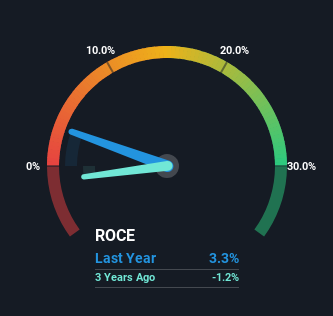- Australia
- /
- Commercial Services
- /
- ASX:NAM
Capital Allocation Trends At Namoi Cotton (ASX:NAM) Aren't Ideal

When researching a stock for investment, what can tell us that the company is in decline? A business that's potentially in decline often shows two trends, a return on capital employed (ROCE) that's declining, and a base of capital employed that's also declining. Basically the company is earning less on its investments and it is also reducing its total assets. Having said that, after a brief look, Namoi Cotton (ASX:NAM) we aren't filled with optimism, but let's investigate further.
Return On Capital Employed (ROCE): What Is It?
For those that aren't sure what ROCE is, it measures the amount of pre-tax profits a company can generate from the capital employed in its business. To calculate this metric for Namoi Cotton, this is the formula:
Return on Capital Employed = Earnings Before Interest and Tax (EBIT) ÷ (Total Assets - Current Liabilities)
0.033 = AU$5.7m ÷ (AU$203m - AU$30m) (Based on the trailing twelve months to February 2023).
So, Namoi Cotton has an ROCE of 3.3%. In absolute terms, that's a low return and it also under-performs the Commercial Services industry average of 7.1%.
View our latest analysis for Namoi Cotton

Above you can see how the current ROCE for Namoi Cotton compares to its prior returns on capital, but there's only so much you can tell from the past. If you'd like to see what analysts are forecasting going forward, you should check out our free report for Namoi Cotton.
SWOT Analysis for Namoi Cotton
- Debt is well covered by .
- Interest payments on debt are not well covered.
- Shareholders have been diluted in the past year.
- Annual earnings are forecast to grow faster than the Australian market.
- Trading below our estimate of fair value by more than 20%.
- Debt is not well covered by operating cash flow.
What Can We Tell From Namoi Cotton's ROCE Trend?
We are a bit worried about the trend of returns on capital at Namoi Cotton. About five years ago, returns on capital were 8.2%, however they're now substantially lower than that as we saw above. Meanwhile, capital employed in the business has stayed roughly the flat over the period. Companies that exhibit these attributes tend to not be shrinking, but they can be mature and facing pressure on their margins from competition. If these trends continue, we wouldn't expect Namoi Cotton to turn into a multi-bagger.
On a side note, Namoi Cotton has done well to pay down its current liabilities to 15% of total assets. So we could link some of this to the decrease in ROCE. Effectively this means their suppliers or short-term creditors are funding less of the business, which reduces some elements of risk. Some would claim this reduces the business' efficiency at generating ROCE since it is now funding more of the operations with its own money.
The Key Takeaway
In the end, the trend of lower returns on the same amount of capital isn't typically an indication that we're looking at a growth stock. Investors haven't taken kindly to these developments, since the stock has declined 25% from where it was five years ago. Unless there is a shift to a more positive trajectory in these metrics, we would look elsewhere.
On a separate note, we've found 2 warning signs for Namoi Cotton you'll probably want to know about.
While Namoi Cotton may not currently earn the highest returns, we've compiled a list of companies that currently earn more than 25% return on equity. Check out this free list here.
Valuation is complex, but we're here to simplify it.
Discover if Namoi Cotton might be undervalued or overvalued with our detailed analysis, featuring fair value estimates, potential risks, dividends, insider trades, and its financial condition.
Access Free AnalysisHave feedback on this article? Concerned about the content? Get in touch with us directly. Alternatively, email editorial-team (at) simplywallst.com.
This article by Simply Wall St is general in nature. We provide commentary based on historical data and analyst forecasts only using an unbiased methodology and our articles are not intended to be financial advice. It does not constitute a recommendation to buy or sell any stock, and does not take account of your objectives, or your financial situation. We aim to bring you long-term focused analysis driven by fundamental data. Note that our analysis may not factor in the latest price-sensitive company announcements or qualitative material. Simply Wall St has no position in any stocks mentioned.
About ASX:NAM
Namoi Cotton
Engages in the ginning and supply chain and marketing of cotton in Australia, China, Japan, South Korea, and Thailand.
Solid track record with excellent balance sheet and pays a dividend.
Market Insights
Community Narratives




